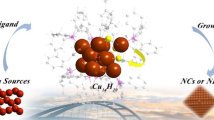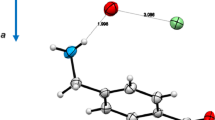Abstract
The title dinuclear complex, [(cis-MoO2L)(μ-O)(cis-MoOL(OH2)], was characterized as a chloroform solvate. In this structure, one Mo atom features a cis-[MoO2]2+ core to which is also bonded a dinegative, tridentate S-benzyl 3-(2-hydroxyphenyl)methylenedithiocarbazate ligand (= L), via sulfur-, oxygen-, and nitrogen-donors, and a water molecule completes the distorted octahedral coordination geometry. A similar NO4S donor set is found for the other Mo atom but in this case, the water molecule is substituted by a bridging oxo atom derived from the first Mo species. Two dimers associate via cooperative O–H⋯O hydrogen bonds to form a supramolecular dimer which, in turn, are linked into supramolecular chains via O–H⋯N hydrogen bonding. The complex crystallizes in the triclinic space group P-1 with a = 10.4714(12) Å, b = 10.7627(14) Å, c = 16.708(2) Å, α = 87.916(7)°, β = 76.249(6)°, γ = 83.610(7)°, and Z = 2.
Index Abstract
Dinuclear [(cis-MoO2L)(μ-O)(cis-MoOL(OH2)], characterized as a chloroform solvate, with octahedral Mo centers, are connected into supramolecular dimers via O–H⋯O hydrogen bonding which are connected via O–H⋯N hydrogen bonds into chains.




Similar content being viewed by others
References
Hille R (1996) Chem Rev 96:2757. doi:10.1021/cr950061t
Yamaguchi Y, Matsumura T, Ichida K, Okamoto K, Nishino T (2007) J Biochem 141:513. doi:10.1093/jb/mvm053
Garattini E, Mendel R, Romao MJ, Wright R, Terao M (2003) Biochem J 372:15. doi:10.1042/BJ20030121
Brondino C, Romão MJ, Moura I, Moura JJG (2006) Curr Opin Chem Biol 10:109. doi:10.1016/j.cbpa.2006.01.034
Johnson MJ, Rees DC, Edams MWW (1996) Chem Rev 96:2817. doi:10.1021/cr950063d
Arzoumanian H, Corao C, Krentzien H, Lopez R, Tervel HJ (1992) J Chem Soc Chem Commun 856. doi:10.1039/c39920000856
Vrdoljak V, Cindric M, Milic D, Matkovic-Calogovic D, Novak P, Kamenar B (2005) Polyhedron 24:1717. doi:10.1016/j.poly.2005.05.002
Afrasiabi Z, Sinn E, Chen J, Ma Y, Rheingold AL, Zakharov LN et al (2004) Inorg Chim Acta 357:271. doi:10.1016/S0020-1693(03)00484-5
Thompson KH, Mcneill JH, Orvig C (1999) Chem Rev 99:2561. doi:10.1021/cr980427c
Bhattacharjee S, Bhattacharyya RJ (1992) J Chem Soc, Dalton Trans 1357. doi:10.1039/dt9920001357
Syamal A, Maurya MR (1986) Trans Met Chem (Weinh) 11:255. doi:10.1007/BF00959926
Higashi T (1995) ABSCOR. Rigaku Corporation, Tokyo, Japan
CrystalClear (2005) User manual. Rigaku/MSC Inc., Rigaku Corporation, The Woodlands, TX
Sheldrick GM (2008) Acta Crystallogr A 64:211
Johnson CK (1976) ORTEP II, report ORNL-5136. Oak Ridge National Laboratory, Oak Ridge, TN
Crystal Impact (2006) DIAMOND, version 3.1c. Crystal Impact GbR, Postfach 1251:D-53002, Bonn, Germany
Spek AL (2003) J Appl Cryst 36:7. doi:10.1107/S0021889802022112
Allen FR (2002) Acta Crystallogr B 58:380
Pramanik NR, Ghosh S, Raychaudhuri TK, Ray S, Butcher RJ, Mandal SS (2004) Polyhedron 23:1595. doi:10.1016/j.poly.2004.03.010
Kim D-W, Lee U, Koo B-K (2004) Bull Korean Chem Soc 25:1071
Dutta SK, McConville DB, Youngs WJ, Chaudhury M (1997) Inorg Chem 36:2517. doi:10.1021/ic960670z
Cremer D, Pople JA (1975) J Am Chem Soc 97:1354. doi:10.1021/ja00839a011
Acknowledgments
The authors gratefully acknowledge the financial assistance from Ministry of Science, Information and Communication Technology, Government of the People’s Republic of Bangladesh, to SKSH. The authors are also thankful to the Bangladesh University Grant Commission for a fellowship to SR.
Author information
Authors and Affiliations
Corresponding authors
Rights and permissions
About this article
Cite this article
Hazari, S.K.S., Palit, D., Roy, T.G. et al. The Crystal and Molecular Structure of the Dinuclear Mo(VI) Species: [(cis-MoO2L)(μ-O)(cis-MoOL(OH2)] · CHCl3 where L = (S-benzyl 3-(2-Hydroxyphenyl)Methylenedithiocarbazate). J Chem Crystallogr 39, 261–265 (2009). https://doi.org/10.1007/s10870-008-9465-0
Received:
Accepted:
Published:
Issue Date:
DOI: https://doi.org/10.1007/s10870-008-9465-0




